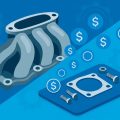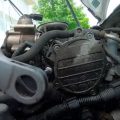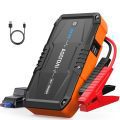In today’s mobile world, reliable power inverters play a crucial role in enabling drivers to use household appliances and charge devices while on the go. However, like any piece of equipment, they require proper maintenance to ensure they function effectively over time. This step-by-step guide is designed to help users understand the essential practices for maintaining a power inverter, ensuring its longevity and efficiency for all your energy needs on the road. Whether you’re a seasoned traveler or a weekend warrior, these straightforward tips will keep your inverter running smoothly for years to come.
![400W Power Inverter, FSATBTNE DC 12V to 110V AC Car Plug Adapter Outlet Converter with [65W PD USB-C] & [18W QC USB-A] Fast Charging Ports and 2 AC Outlets Car Power Inverters for Vehicles](https://m.media-amazon.com/images/I/41GUdr-xNNL._SS520_.jpg)


Regular Cleaning
Clean the power inverter regularly to prevent dust and debris buildup that can lead to overheating and reduced efficiency. Disconnect the inverter from all power sources before starting the cleaning process to ensure safety. Use a damp cloth to gently wipe the exterior surfaces, removing any grime or fingerprints. For the vents and fans, utilize a soft brush to carefully remove dust and dirt, ensuring that airflow is not obstructed. Pay special attention to any accumulated debris in hard-to-reach areas, as this can significantly impact the inverter’s performance.
Check Connections
Inspect all electrical connections every few months to ensure optimal performance and safety. Start by visually examining each connection point, looking for any signs of wear, corrosion, or damage. Pay close attention to areas where cables connect to devices or power sources, as these are often the most vulnerable. For example, if you notice any white or green powdery substances on a connection, this indicates corrosion that could affect the system’s reliability.
Check that all cables are tightly connected; gently tug on them to confirm they are secure. If any cables appear frayed or damaged, replace them immediately. For instance, if a power cable to a tool shows exposed wiring, you must disconnect the tool and replace the cable with a new one to prevent electrical hazards. Regularly maintaining these connections not only extends the life of your equipment but also ensures a safer working environment.
Monitor Temperature
Monitor the operating temperature of the inverter regularly. Check the manufacturer’s specifications for the optimal temperature range and use a thermometer to verify if the inverter is operating within that range. If the temperature exceeds the recommended limits, take action immediately. Ensure the inverter is placed in a well-ventilated area, away from direct sunlight and heat sources like radiators or ovens. For example, if the inverter is located in a cramped closet, relocate it to a more spacious environment where air can circulate freely.
Install additional cooling solutions if the inverter frequently shuts down due to high temperatures. Consider adding a small fan near the inverter to enhance airflow. Alternatively, use a temperature-controlled cooling system that activates when the inverter reaches a specific temperature threshold. If relocating the inverter is an option, find a cooler spot, such as a basement or a shaded outdoor area, to help reduce its operating temperature. Regularly inspect the inverter and surrounding area for dust accumulation, which can impede airflow, and clean it as needed.
Test Functionality
Regularly test the power inverter by connecting various devices, such as laptops, lights, and small appliances. Start with low-wattage devices to gauge the inverter’s performance. Monitor the inverter for any unusual sounds or overheating during operation. If any device fails to operate properly, disconnect it immediately and check for error codes or indicators on the inverter’s display. This process allows you to catch minor issues, such as insufficient power output or faulty connections, before they escalate into significant problems.
Repeat this testing periodically, ideally every few months or after any major power surge or outage. Keep a log of the devices tested and their performance outcomes. Use this information to recognize patterns or recurring issues, which can help in troubleshooting and maintaining the inverter’s reliability. Always prioritize safety by ensuring the inverter is turned off while making connections or disconnections, and avoid overloading it with devices beyond its rated capacity.
Battery Maintenance
Check fluid levels regularly. If your battery is a lead-acid type, ensure the electrolyte levels are sufficient. Add distilled water if needed, but do not overfill. It’s important to maintain the recommended level, usually just above the plates.
Clean terminals and connections. Use a mixture of baking soda and water to scrub away corrosion on the battery terminals. Make sure to disconnect the battery before cleaning to prevent any short circuits. After cleaning, apply a thin layer of petroleum jelly on the terminals to inhibit future corrosion.
Ensure the battery is charged adequately. Monitor the charge level using a multimeter. Aim for a voltage reading that aligns with the manufacturer’s specifications—typically around 12.6 volts for a fully charged lead-acid battery. If the battery is frequently undercharged, consider investing in a smart charger to maintain optimal charge levels.
Follow the manufacturer’s guidelines for battery care. Each battery type has specific recommendations. For instance, sealed maintenance-free batteries require less attention than traditional flooded batteries. Refer to the user manual for particular care instructions and maintenance schedules.
Review User Manual
Periodically review the power inverter’s user manual for specific maintenance recommendations and troubleshooting tips. This practice ensures compliance with manufacturer guidelines and helps prolong the unit’s lifespan.
- Set a reminder to check the user manual every few months.
- Look for sections on routine maintenance, such as cleaning dust from vents or checking connections.
- Follow troubleshooting tips for common issues, like resetting the inverter or checking the battery status.
- Note any recommended replacement parts or intervals for such parts as fuses or filters.
For example, if the manual suggests cleaning the inverter’s exterior with a dry cloth, make it a habit to do so regularly. If the manual advises checking the voltage output periodically, use a multimeter to ensure everything is functioning correctly. Following these steps helps maintain optimal performance and longevity of your power inverter.
Key Takeaways for Longevity
In conclusion, proper maintenance of your power inverter is essential for ensuring its longevity and optimal performance. By incorporating regular cleaning, inspecting connections, monitoring temperature, testing functionality, caring for the battery, and consulting the user manual into your routine, you can significantly enhance the reliability and efficiency of your inverter. Adhering to these practices will not only extend the life of your equipment but also provide peace of mind during critical power needs.
Essential Equipment List
- Soft cloth or microfiber cloth
- Vacuum cleaner with a brush attachment
- Screwdriver set
- Multimeter
- Temperature gauge or thermal camera
- Battery terminal cleaner or wire brush
- Wrench set
- Safety gloves
- Safety goggles
- Cleaning solution (non-corrosive)
- Torque wrench
- Replacement fuses (if applicable)
- User manual for the inverter


Essential Maintenance Advice
- Regularly Clean the Inverter: Dust and debris can accumulate, affecting performance. Clean the exterior and ensure ventilation openings are unobstructed
- Check Connections: Periodically inspect all connections and terminals for corrosion or loose wires to ensure optimal conductivity
- Monitor Battery Health: Use high-quality batteries and check their state regularly. Replace batteries as needed to avoid strain on the inverter
- Avoid Overloading: Ensure that the total wattage of devices connected does not exceed the inverter’s rated capacity to prevent overheating
- Maintain Proper Ventilation: Install the inverter in a well-ventilated area to prevent overheating, and avoid enclosing it in tight spaces
- Keep Operating Temperature in Check: Use the inverter within its specified temperature range to prevent thermal damage
- Perform Regular Function Tests: Periodically run the inverter under load to verify that it is functioning properly and efficiently
- Implement Surge Protection: Use surge protectors to shield the inverter from voltage spikes that could cause damage
- Store Properly When Not in Use: If the inverter is not in use for an extended period, store it in a dry, cool place and disconnect it from power sources
- Consult the Manufacturer’s Manual: Follow the specific maintenance guidelines provided by the manufacturer for the best practices tailored to your inverter model
Maximizing Efficiency: Step-by-Step Guide to Utilizing Vehicle Power Inverters
- Choose the Right Inverter: Select an inverter that matches your power needs. Check the wattage requirements of the devices you plan to use, and opt for an inverter with a higher wattage rating to ensure it can handle the load
- Proper Installation: Connect the inverter to your vehicle’s power source, typically the car’s battery, using the provided cables. Ensure the connections are secure and follow the manufacturer’s instructions to prevent any electrical issues
- Use in a Well-Ventilated Area: Inverters can generate heat during operation. Place the inverter in a well-ventilated area of your vehicle to avoid overheating. Avoid covering it with blankets or other materials while in use
- Monitor Power Usage: Keep track of the devices you are powering to avoid exceeding the inverter’s capacity. Overloading the inverter can lead to malfunction or damage to your devices
- Safety Precautions: Always follow safety guidelines, such as not using the inverter while the engine is off for extended periods to prevent battery drain. Also, ensure that your devices are compatible with the inverter to prevent damage
Your Guide to Choosing Dependable Vehicle Power Inverters
What is a power inverter and how does it function in a vehicle?
A power inverter is an electronic device that converts direct current (DC) from a vehicle’s battery into alternating current (AC), which is used to power a variety of electronic devices and appliances that typically require AC power to operate.
In a vehicle, the power inverter is connected to the car’s battery, drawing power from it when needed. The inverter uses a circuit to transform the DC electricity (which flows in one direction) from the battery into AC electricity (which alternates direction) at either 120V or 240V, depending on its design. This allows users to plug in devices such as laptops, mobile phone chargers, or small appliances that would normally be used in a home or office setting.
Power inverters come in various sizes and power ratings, ranging from small portable units that can power low-wattage devices, to larger inverters that can handle heavier loads. They often feature safety mechanisms like overload protection and short-circuit protection to ensure safe operation while in use. Overall, power inverters are valuable tools for providing electrical power in situations where traditional AC power sources are not available.








Good to know I should keep it in a cooler place. My garage gets super hot.
Great tips! I never knew cleaning the fans was so important. Thanks!
Thanks for the reminder! I’ll make sure to read the manual more closely.
Can’t believe I’ve been using mine without a regular check-up. Learning something new every day!
Wow, I thought inverters were just plug-and-play. Time to step up my maintenance game!
Anyone else here have issues with their inverter beeping? Could it be a maintenance thing?
This is just what I needed! Keeping my inverter running like new is a must.
I love my power inverter, but I didn’t realize how much maintenance it needed.
I always forget to check the battery levels. Gonna add that to my to-do list!
This article is super helpful! I’ll definitely be checking the connections more often.